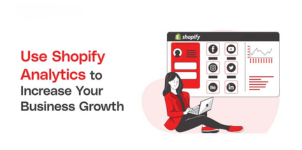Shopify Analytics: Understanding Key Metrics to Grow Your Business.
Success in e-commerce isn’t just about setting up a store and selling products. To truly grow your Shopify business, you need to understand and track the right data. Shopify Analytics provides store owners with key metrics and insights that help guide decision-making, from marketing strategies to inventory management. Whether you’re new to e-commerce or have completed a Shopify course, learning how to leverage Shopify Analytics is crucial for your store’s growth.
In this blog, we’ll dive into the most important Shopify Analytics metrics that can help you understand your store’s performance and make data-driven decisions.
1. Total Sales: Your Store’s Revenue at a Glance
Total sales are one of the most basic yet crucial metrics for any e-commerce business. It gives you a clear picture of your store’s overall revenue for a specific period. Tracking this metric allows you to measure the success of marketing campaigns, promotions, and other efforts. If you've taken a Shopify course in Lahore or Shopify course in Pakistan, you likely understand the importance of regularly reviewing this metric to track growth.
Total sales data can be filtered by specific periods, such as daily, weekly, monthly, or yearly, helping you identify trends over time.
2. Conversion Rate: Turning Visitors into Buyers
Your store's conversion rate is the percentage of visitors who complete a purchase. A high conversion rate means you’re effectively turning visitors into customers, while a low rate indicates potential issues in your sales funnel. If you’ve completed a Shopify dropshipping course or Shopify training, you’re familiar with how crucial this metric is for store optimization.
To improve your conversion rate, you can focus on elements such as user experience, website speed, product descriptions, and more. A successful Shopify dropshipping course free often emphasizes the importance of continually optimizing this metric.
3. Average Order Value (AOV): Maximizing Sales per Customer
3. Average Order Value (AOV): Maximizing Sales per Customer
Average Order Value (AOV) represents the average amount spent by customers per transaction. If you’re looking to increase your revenue without increasing traffic, boosting AOV is key. Whether you've taken a Shopify online course or learned through Shopify courses free, increasing AOV can be done through upselling, cross-selling, or offering free shipping on higher-value orders.
Monitoring AOV helps you determine the effectiveness of your pricing strategies and promotions, allowing you to optimize for better sales.
4. Customer Lifetime Value (CLV): Understanding Long-Term Customer Worth
4. Customer Lifetime Value (CLV): Understanding Long-Term Customer Worth
Customer Lifetime Value (CLV) measures the total revenue you can expect from a single customer over the lifetime of their relationship with your store. If you've completed a Shopify full course or learned from best Shopify course resources, you understand the importance of nurturing customer relationships for long-term growth.
Increasing CLV involves improving customer retention, offering loyalty programs, and upselling. The higher the CLV, the more valuable your customers are, making this a critical metric for growing your business.
5. Traffic Sources: Understanding Where Your Visitors Come From
Shopify Analytics also provides detailed insights into your traffic sources. Knowing where your visitors come from (social media, organic search, email, or paid ads) helps you identify which channels are driving the most traffic and which ones need improvement. If you've taken a Shopify course in Lahore or Shopify courses dropshipping, you understand how crucial it is to focus on high-performing traffic sources.
You can use this data to allocate your marketing budget more effectively, focusing on channels that bring in the most valuable customers.
6. Customer Behavior: Tracking User Actions on Your Store
Shopify Analytics provides insights into customer behavior on your store, including pages viewed, time spent on site, and actions taken. This data helps you understand how visitors navigate your store and what areas need improvement. If you've taken a Shopify free course or learned through Shopify training, you know the importance of monitoring user behavior to optimize the shopping experience.
Analyzing customer behavior data can help you identify which product pages are performing well and which may need better descriptions or images to convert visitors into buyers.
7. Abandoned Cart Rate: Recovering Lost Sales
Abandoned carts are a common challenge for e-commerce businesses. Shopify Analytics provides data on the number of visitors who add items to their cart but leave without completing the purchase. If you’ve completed any Shopify courses, you’re likely familiar with strategies to recover these lost sales, such as abandoned cart emails or retargeting ads.
A high abandoned cart rate may signal issues with your checkout process, pricing, or shipping options. Addressing these issues can lead to an increase in conversions.
8. Returning Customer Rate: Building Brand Loyalty
Returning Customer Rate measures the percentage of customers who return to make additional purchases. A high returning customer rate indicates strong customer loyalty, which is crucial for long-term growth. If you've completed a Shopify course in Pakistan or a Shopify dropshipping course free, you know that focusing on customer retention can be more cost-effective than acquiring new customers.
You can increase this metric by offering loyalty programs, discounts, or personalized recommendations to your existing customers.
Conclusion
Understanding and leveraging Shopify Analytics is key to making data-driven decisions that will help grow your e-commerce business. Whether you’re just starting out with a Shopify course or have completed extensive Shopify training, tracking key metrics like conversion rates, average order value, and traffic sources will provide insights to optimize your store for success. By focusing on these analytics, you can take actionable steps to improve your store’s performance, drive more traffic, and boost sales.

